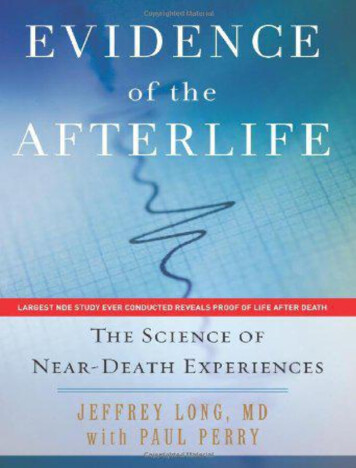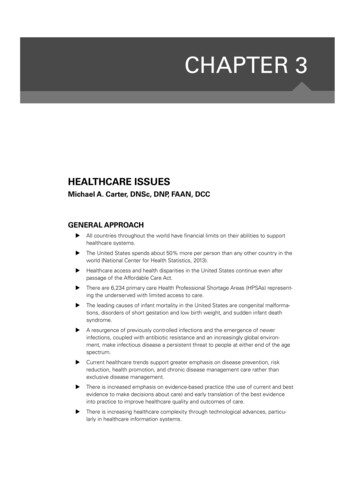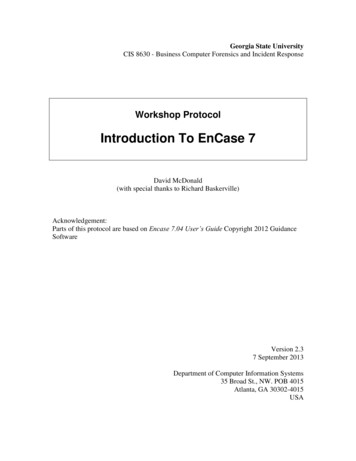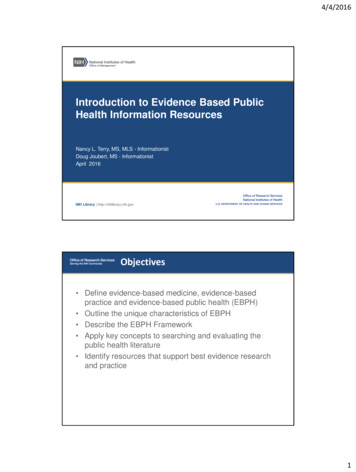
Transcription
4/4/2016Introduction to Evidence Based PublicHealth Information ResourcesNancy L. Terry, MS, MLS - InformationistDoug Joubert, MS - InformationistApril 2016NIH Library http://nihlibrary.nih.govObjectives Define evidence-based medicine, evidence-based practice and evidence-based public health (EBPH)Outline the unique characteristics of EBPHDescribe the EBPH FrameworkApply key concepts to searching and evaluating thepublic health literatureIdentify resources that support best evidence researchand practice1
4/4/2016Online ResourcesEBMEBPEBPH2
4/4/2016Evidence-Based Medicine Evidence-based medicine (EBM) involvesconscientiously working with patients to help themresolve or cope with problems related to their physical,mental, and social health (Guyatt, Rennie, Meade, Cook,& American Medical Association., 2015). Evidence-based decision making grew out of a desire tomove beyond “authority-based decision making,” inwhich decisions were made by consensus, by anecdotalexperience, or tradition (Gambrill, 2006).What is EBP? It did not take long for people to realize that theprinciples of EBM were equally applicable to otherprofessions. So, evidence-based health care and evidence-basedpractice covers the full range of clinical applications ofthe evidence-based approach to patient care. EBP has been adopted by nurses, social workers, andpolicy analysts. And parts of EBP are embedded in the EBPHframework.Guyatt, Rennie, Meade, Cook, & American Medical Association (2015)3
4/4/2016Evidence-based Public Health“Process of integrating science-basedinterventions with community preferencesto improve the health of populations”Brownson, R. C. (2011)EBPH CharacteristicsBest availableresearch evidenceEnvironmentand acteristics,needs, erexpertiseBrownson (2013)4
4/4/2016EBM & EBPH DifferencesCharacteristicsEBMEBPHQuality & volume ofevidenceExperimental studiesQuasi-experimentalstudiesTime fromintervention tooutcomeshorter intervallonger intervalTrainingmore formal –less formal – nocertification required certificationrequired*Decision makingIndividual (mostly)Group (mostly)Jacobs, J. A., et al. (2012)Brownson, R. C. (2013)Public Health Practice What makes public healthinterventions differentfrom medicalinterventions? Scale Situational variability Complexity of theinterventionShelton, J. D. (2014)5
4/4/2016Scale Public healthinterventions usuallyoperate at a larger scale,and address issues thatspan clinical, behavior,and structuraldimensions.Shelton, J. D. (2014)Situational variability Because situations canvary so widely in publichealth, the ‘‘externalvalidity’’ orgeneralizability ofevidence to othersituations is absolutelycrucial for public healthapplications. Yet, with RCTs?Shelton, J. D. (2014)6
4/4/2016Complexity of the intervention What is the best set ofinterventions for particularsettings? How should theinterventions beorganized and deliveredwithin existing systems? What will make theintervention sustainable?Shelton, J. D. (2014)EBPH Framework7
4/4/2016EBPH FrameworkCommunityAssessmentWhat is theissue?Search luate theinterventionBrownson, Fielding, & Maylahn (2009)EBPH FrameworkCommunityAssessmentWhat is theissue?Search luate theinterventionBrownson, Fielding, & Maylahn, (2009)Finke (2009)8
4/4/2016EBPH FrameworkSearching the literatureLevels of Evidence9
4/4/2016Defining EvidencePublic health evidence is usually the result of a complex cycle of observation, theory, andexperiment.EBMCommunityGuideAHRQRE-AIMLevels ofEvidenceBrownson, Fielding, & Maylahn (2009)Different forms of evidenceObjective Systematic reviewsScientific literaturePublic health surveillance dataProgram evaluationsSubjective Media/marketing data Word of mouth Personal experienceLike beauty, evidence is in the eye of thebeholder Brownson, Fielding, & Maylahn (2009)10
4/4/2016Types of Evidence: ComparisonCharacterType 1Type 2Type 3Typical data/relationshipSize and strength ofpreventableRisk or diseaserelationshipRelative effectivenessof interventionInformation on theadaptation andtranslation of aneffectiveinterventionSocially intact groupsor community wideSocially intact groups orcommunity wideCommon setting Clinic or controlledcommunitysettingExampleSmoking causes lung Targeted campaign tocancerreduce smokingUnderstanding theimplications of theintervention toparticular segmentsQuantityMoreLessLessActionSomething shouldbe doneImplementing theinterventionHow an interventionshould beimplementedType 2 Evidence levelsBrownson nson, Fielding, & Maylahn (2009)11
4/4/2016Emerging EvidenceCategoryHow establishedRigorExamplesEmerging Ongoing work Practice basedsummaries Evaluation worksin progress Formativeevaluation data Potentially highreaching Face value Evaluabilityassessments Pilot studies Projects fundedby healthfoundationsBrownson, Fielding, & Maylahn (2009)Promising EvidenceCategoryHow establishedRigorExamplesPromisingWritten programevaluationwithout formal peerreview. Cumulativeevidence ofeffectiveness Formativeevaluation data State or federalgovernmentreports (withoutpeer review) ConferencepresentationsBrownson, Fielding, & Maylahn (2009)12
4/4/2016Effective EvidenceCategoryHow establishedRigorExamplesEffectivePeer-review Based on studydesign andexecution External validity Assessing risk orbenefits Costs and costeffectiveness Articles in thescientificliterature Research-testedinterventionPrograms Technical reportswith peer reviewBrownson, Fielding, & Maylahn (2009)Evidence-based EvidenceCategoryHow establishedRigorExamplesEvidence-basedPeer review viasystematic ornarrative review Based on studydesign andexecution External validity Assessing risk orbenefits Costs and costeffectiveness CommunityGuide Cochrane orCampbell reviews Narrative reviewsbased onpublishedliteratureBrownson, Fielding, & Maylahn (2009)13
4/4/2016Finding the Evidence1. Frame research question2. Select databases,3.4.5.6.websites, and othersourcesChoose a search strategyApply a methodologicalstandards for evaluating astudy’s scientific qualityPerform the review so thatit can be reproduced byothersSynthesizing the resultsFink, A. (2013)PICO Question Ask for specific knowledge to inform decisions oractions, and have four essential components: P: The patient, the population, or the problem. I: The intervention, exposure, or test. C: The comparison intervention, exposure, or test (if relevant). O: The outcome of importance, including time (if relevant).Straus (2011)14
4/4/2016PICO Questions: The P What is the relevant population? What are the relevant characteristics for yourpopulation? This should be defined in terms of health condition, age,gender, ethnic background, comorbidities, andsocioeconomic status. Examples of strong population component include: Homeless male clients diagnosed with PTSD. Hispanic adolescents residing in single-parent households.Falzon (2010)Flanagan (2014)PICO Questions: The I The interventions or exposures: An intervention might be therapeutic, diagnostic, oradministrative. Exposure refers to something that is happening unintentionallybut is having an effect on health. Again, this should be as detailed as possible.Falzon (2010)Flanagan (2014)15
4/4/2016PICO Questions: The C What is the intervention being compared to? Example: interventions to reduce smoking rates – healtheducation programs vs. smoking bans Considering these different comparators ensures that thechosen comparison is appropriate to the population.Falzon (2010)Flanagan (2014)PICO Questions: The O What are the population-relevant consequences of theexposures in which we are interested? What can I hope to accomplish, measure, improve, oraffect? We may also be interested in the consequences tosociety, including cost or resource use. It may also be important to specify the period of interest.Falzon (2010)Flanagan (2014)16
4/4/2016Selected ResourcesPublic Health Information Sources Journal Literature Books Conference Proceedings & AbstractsDissertations & ThesesHealth Impact AssessmentsGovernment ReportsPolicy Statements, Laws &Regulations Surveillance Data Newsletters Teleconferences & WebcastsAlert SystemsListservsInternet SourcesExpert Knowledge &OpinionGrey Literature17
4/4/2016Public Health Evidence Sources Systematic Reviews Evidence Based Guidelines Pre-formulated Searches Best and Model Practices Bibliographic Databases Public Health Journals Health Data and Statistics Legislation and PolicyCochrane Library18
4/4/201619
4/4/2016Health EvidenceHealth Evidence Searchable Database20
4/4/2016Health Evidence Practice ToolsPublic Health Evidence Sources Systematic Reviews Evidence Based Guidelines Pre-formulated Searches Best and Model Practices Bibliographic Databases Public Health Journals Health Data and Statistics Legislation and Policy21
4/4/2016Community GuideNational Guideline Clearinghouse22
4/4/2016NHS - NICEPublic Health Evidence Sources Systematic Reviews Evidence Based Guidelines Pre-formulated Searches Best and Model Practices Bibliographic Databases Public Health Journals Health Impact Assessments Health Data and Statistics Legislation and Policy23
4/4/2016Healthy People 2020 QueriesPublic Health Evidence Sources Systematic Reviews Evidence Based Guidelines Pre-formulated Searches Best and Model Practices Bibliographic Databases Public Health Journals Health Impact Assessments Health Data and Statistics Legislation and Policy24
4/4/2016NACCHOProfile of State Public Health25
4/4/2016Public Health Evidence Sources Evidence Based Guidelines Systematic Reviews Pre-formulated Searches Best and Model Practices Bibliographic Databases Public Health Journals Health Impact Assessments Health Data and Statistics Legislation and PolicyPubMed – Special Queries26
4/4/2016ScopusWeb of Science27
4/4/2016Public Health Evidence Sources Evidence Based Guidelines Systematic Reviews Pre-formulated Searches Best and Model Practices Bibliographic Databases Public Health Journals Health Impact Assessments Health Data and Statistics Legislation and PolicyEvidence Based Practice Portal28
4/4/2016Public Health Evidence Sources Evidence Based Guidelines Systematic Reviews Pre-formulated Searches Best and Model Practices Bibliographic Databases Public Health Journals Health Impact Assessments Health Data and Statistics Legislation and PolicyHealth Impact Assessment Sites Dannenberg AL, Bhatia R, Cole BL, et al. Use of healthimpact assessment in the U.S.: 27 case studies, 1999–2007.Am J Prev Med 2008;34(3):241–256. CDC Healthy Places Health Impact Assessment Health Impact Project – PEW Trust International Health Impact Assessment Consortium World Health Organization Health Impact Assessment UCLA HIA Clearinghouse Learning & Info Center29
4/4/2016Public Health Evidence Sources Evidence Based Guidelines Systematic Reviews Pre-formulated Searches Best and Model Practices Bibliographic Databases Public Health Journals Health Impact Assessments Health Data and Statistics Legislation and Policy59NIH Library http://nihlibrary.nih.govPHPartners – Data and Stats30
4/4/2016Public Health Evidence Sources Evidence Based Guidelines Systematic Reviews Pre-formulated Searches Best and Model Practices Bibliographic Databases Public Health Journals Health Impact Assessments Health Data and Statistics Legislation and Policy61NIH Library http://nihlibrary.nih.govPolicy Archive / Policy File31
4/4/2016Policy Centers Academy Health - Health policy information on the evolving health system. Center for Health Care Strategies - Health policy resource center information onaccess, quality and cost-effectiveness in publicly financed health care. Commonwealth Fund - Access independent research on health care issues andhealth care practice and policy. Global Health Policy Research Network - Research on high-priority global healthpolicy issues Kaiser Family Foundation Health and Law - Policy research and analysis, and indepth health policy news coverage. National Health Policy Forum - Health policy information for federal health policy stafffeaturing basic education on specific policies, programs, and issues, to complexanalyses of the health care system, including information from important researchstudies, demonstrations, and innovative community efforts. Robert Wood Johnson Foundation - Information and funding for research andprograms to build a Culture of Health. PH Partners Legislation and Policy - Resources to support legislation and policy atthe state and federal levels.Social Media and Blogs32
4/4/2016Blogs and Twitter followsNancy TerryDouglas IH Library http://nihlibrary.nih.gov33
Public health interventions usually operate at a larger scale, and address issues that span clinical, behavior, and structural dimensions. Shelton, J. D. (2014) Because situations can vary so widely in public health, the ‘‘external validity’’ or generalizability of evidence to other situations
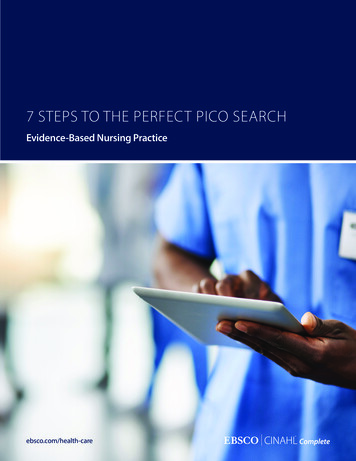
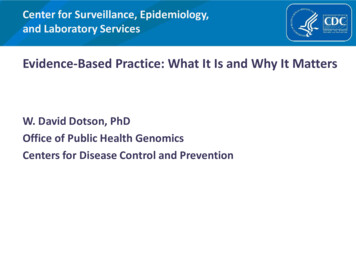

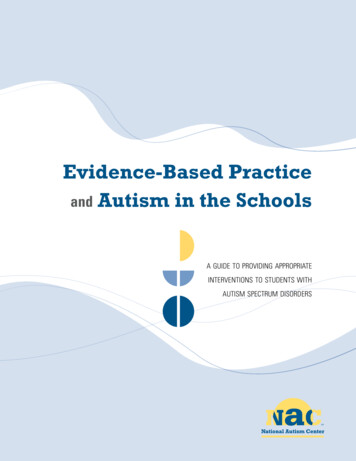
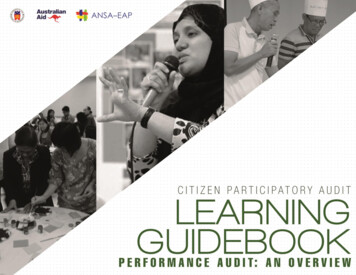
![project2 Encase.pptx [Read-Only]](/img/12/project2-encase.jpg)
